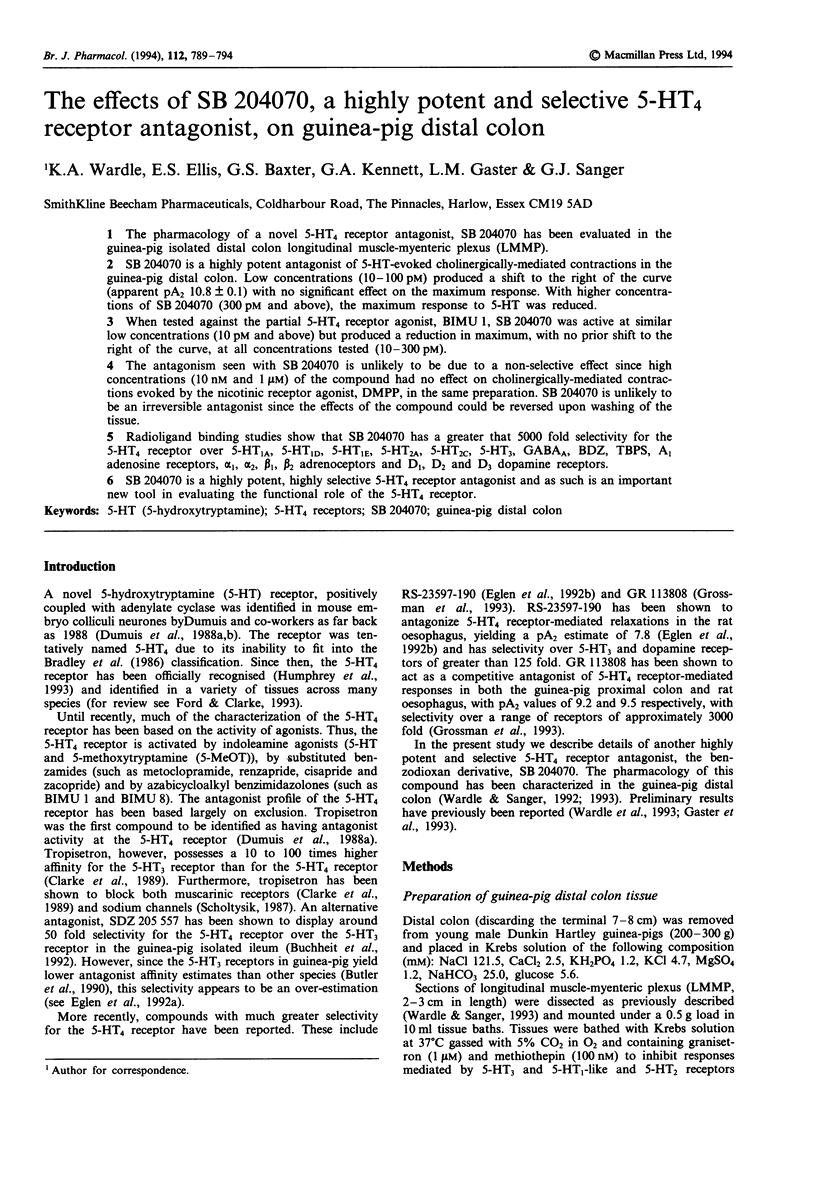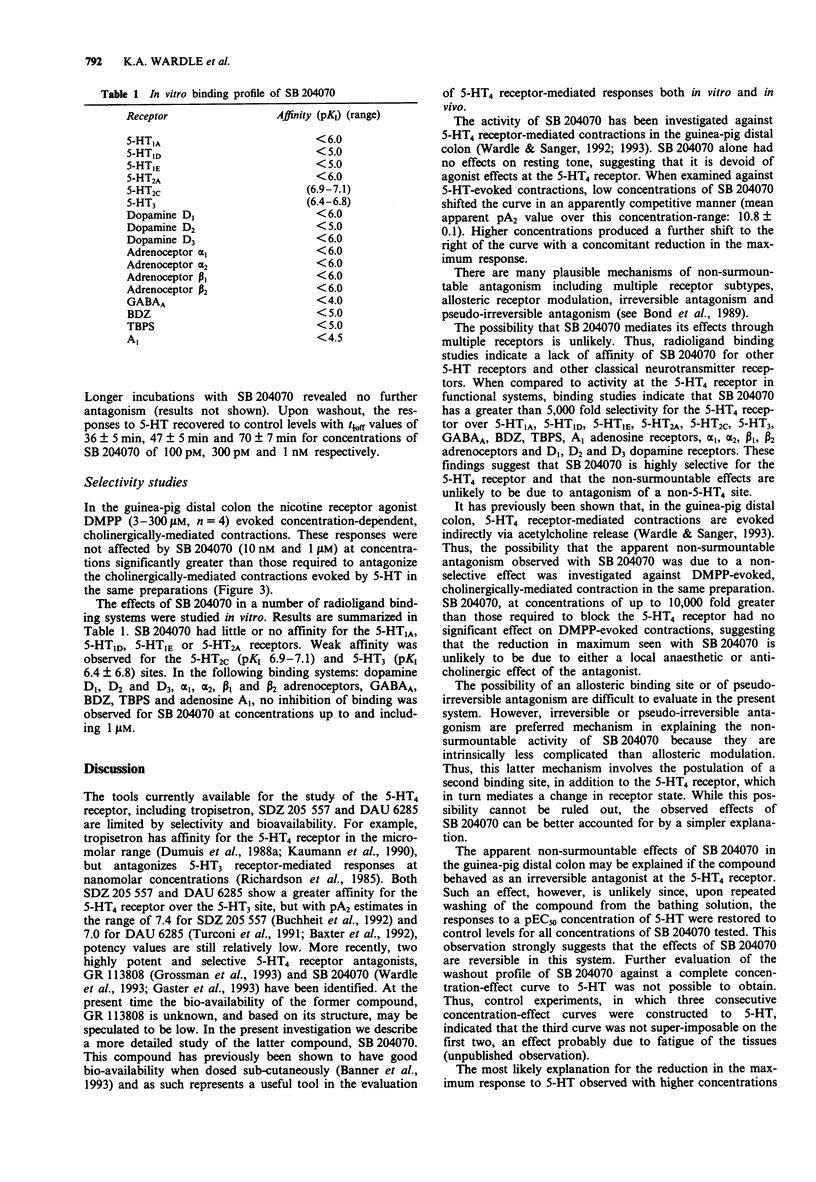Abstract
1. The pharmacology of a novel 5-HT4 receptor antagonist, SB 204070 has been evaluated in the guinea-pig isolated distal colon longitudinal muscle-myenteric plexus (LMMP). 2. SB 204070 is a highly potent antagonist of 5-HT-evoked cholinergically-mediated contractions in the guinea-pig distal colon. Low concentrations (10-100 pM) produced a shift to the right of the curve (apparent pA2 10.8 +/- 0.1) with no significant effect on the maximum response. With higher concentrations of SB 204070 (300 pM and above), the maximum response to 5-HT was reduced. 3. When tested against the partial 5-HT4 receptor agonist, BIMU 1, SB 204070 was active at similar low concentrations (10 pM and above) but produced a reduction in maximum, with no prior shift to the right of the curve, at all concentrations tested (10-300 pM). 4. The antagonism seen with SB 204070 is unlikely to be due to a non-selective effect since high concentrations (10 nM and 1 microM) of the compound had no effect on cholinergically-mediated contractions evoked by the nicotinic receptor agonist, DMPP, in the same preparation. SB 204070 is unlikely to be an irreversible antagonist since the effects of the compound could be reversed upon washing of the tissue. 5. Radioligand binding studies show that SB 204070 has a greater that 5000 fold selectivity for the 5-HT4 receptor over 5-HT1A, 5-HT1D, 5-HT1E, 5-HT2A, 5-HT2C, 5-HT3, GABAA, BDZ, TBPS, A1 adenosine receptors, alpha 1, alpha 2, beta 1, beta 2 adrenoceptors and D1, D2 and D3 dopamine receptors.(ABSTRACT TRUNCATED AT 250 WORDS)
Full text
PDF





Selected References
These references are in PubMed. This may not be the complete list of references from this article.
- ARUNLAKSHANA O., SCHILD H. O. Some quantitative uses of drug antagonists. Br J Pharmacol Chemother. 1959 Mar;14(1):48–58. doi: 10.1111/j.1476-5381.1959.tb00928.x. [DOI] [PMC free article] [PubMed] [Google Scholar]
- Bond R. A., Ornstein A. G., Clarke D. E. Unsurmountable antagonism to 5-hydroxytryptamine in rat kidney results from pseudoirreversible inhibition rather than multiple receptors or allosteric receptor modulation. J Pharmacol Exp Ther. 1989 May;249(2):401–410. [PubMed] [Google Scholar]
- Bradley P. B., Engel G., Feniuk W., Fozard J. R., Humphrey P. P., Middlemiss D. N., Mylecharane E. J., Richardson B. P., Saxena P. R. Proposals for the classification and nomenclature of functional receptors for 5-hydroxytryptamine. Neuropharmacology. 1986 Jun;25(6):563–576. doi: 10.1016/0028-3908(86)90207-8. [DOI] [PubMed] [Google Scholar]
- Buchheit K. H., Gamse R., Pfannkuche H. J. SDZ 205-557, a selective, surmountable antagonist for 5-HT4 receptors in the isolated guinea pig ileum. Naunyn Schmiedebergs Arch Pharmacol. 1992 Apr;345(4):387–393. doi: 10.1007/BF00176615. [DOI] [PubMed] [Google Scholar]
- Butler A., Elswood C. J., Burridge J., Ireland S. J., Bunce K. T., Kilpatrick G. J., Tyers M. B. The pharmacological characterization of 5-HT3 receptors in three isolated preparations derived from guinea-pig tissues. Br J Pharmacol. 1990 Nov;101(3):591–598. doi: 10.1111/j.1476-5381.1990.tb14126.x. [DOI] [PMC free article] [PubMed] [Google Scholar]
- Cheng Y., Prusoff W. H. Relationship between the inhibition constant (K1) and the concentration of inhibitor which causes 50 per cent inhibition (I50) of an enzymatic reaction. Biochem Pharmacol. 1973 Dec 1;22(23):3099–3108. doi: 10.1016/0006-2952(73)90196-2. [DOI] [PubMed] [Google Scholar]
- Clarke D. E., Craig D. A., Fozard J. R. The 5-HT4 receptor: naughty, but nice. Trends Pharmacol Sci. 1989 Oct;10(10):385–386. doi: 10.1016/0165-6147(89)90177-6. [DOI] [PubMed] [Google Scholar]
- DeLean A., Munson P. J., Rodbard D. Simultaneous analysis of families of sigmoidal curves: application to bioassay, radioligand assay, and physiological dose-response curves. Am J Physiol. 1978 Aug;235(2):E97–102. doi: 10.1152/ajpendo.1978.235.2.E97. [DOI] [PubMed] [Google Scholar]
- Dumuis A., Bouhelal R., Sebben M., Bockaert J. A 5-HT receptor in the central nervous system, positively coupled with adenylate cyclase, is antagonized by ICS 205 930. Eur J Pharmacol. 1988 Jan 27;146(1):187–188. doi: 10.1016/0014-2999(88)90503-1. [DOI] [PubMed] [Google Scholar]
- Dumuis A., Bouhelal R., Sebben M., Cory R., Bockaert J. A nonclassical 5-hydroxytryptamine receptor positively coupled with adenylate cyclase in the central nervous system. Mol Pharmacol. 1988 Dec;34(6):880–887. [PubMed] [Google Scholar]
- Elswood C. J., Bunce K. T., Humphrey P. P. Identification of putative 5-HT4 receptors in guinea-pig ascending colon. Eur J Pharmacol. 1991 Apr 17;196(2):149–155. doi: 10.1016/0014-2999(91)90421-l. [DOI] [PubMed] [Google Scholar]
- Ford A. P., Clarke D. E. The 5-HT4 receptor. Med Res Rev. 1993 Nov;13(6):633–662. doi: 10.1002/med.2610130603. [DOI] [PubMed] [Google Scholar]
- Gaster L. M., Jennings A. J., Joiner G. F., King F. D., Mulholland K. R., Rahman S. K., Starr S., Wyman P. A., Wardle K. A., Ellis E. S. (1-Butyl-4-piperidinyl)methyl 8-amino-7-chloro-1,4-benzodioxane-5-carboxylate hydrochloride: a highly potent and selective 5-HT4 receptor antagonist derived from metoclopramide. J Med Chem. 1993 Dec 10;36(25):4121–4123. doi: 10.1021/jm00077a018. [DOI] [PubMed] [Google Scholar]
- Grossman C. J., Kilpatrick G. J., Bunce K. T. Development of a radioligand binding assay for 5-HT4 receptors in guinea-pig and rat brain. Br J Pharmacol. 1993 Jul;109(3):618–624. doi: 10.1111/j.1476-5381.1993.tb13617.x. [DOI] [PMC free article] [PubMed] [Google Scholar]
- Hamblin M. W., Metcalf M. A. Primary structure and functional characterization of a human 5-HT1D-type serotonin receptor. Mol Pharmacol. 1991 Aug;40(2):143–148. [PubMed] [Google Scholar]
- Humphrey P. P., Hartig P., Hoyer D. A proposed new nomenclature for 5-HT receptors. Trends Pharmacol Sci. 1993 Jun;14(6):233–236. doi: 10.1016/0165-6147(93)90016-d. [DOI] [PubMed] [Google Scholar]
- Kaumann A. J., Sanders L., Brown A. M., Murray K. J., Brown M. J. A 5-hydroxytryptamine receptor in human atrium. Br J Pharmacol. 1990 Aug;100(4):879–885. doi: 10.1111/j.1476-5381.1990.tb14108.x. [DOI] [PMC free article] [PubMed] [Google Scholar]
- Leff P., Martin G. R. The classification of 5-hydroxytryptamine receptors. Med Res Rev. 1988 Apr-Jun;8(2):187–202. doi: 10.1002/med.2610080203. [DOI] [PubMed] [Google Scholar]
- Martin G. R. Current problems and future requirements for 5-hydroxytryptamine receptor classification. Neuropsychopharmacology. 1990 Oct-Dec;3(5-6):321–333. [PubMed] [Google Scholar]
- Nelson D. R., Thomas D. R. [3H]-BRL 43694 (Granisetron), a specific ligand for 5-HT3 binding sites in rat brain cortical membranes. Biochem Pharmacol. 1989 May 15;38(10):1693–1695. doi: 10.1016/0006-2952(89)90319-5. [DOI] [PubMed] [Google Scholar]
- Pazos A., Hoyer D., Palacios J. M. The binding of serotonergic ligands to the porcine choroid plexus: characterization of a new type of serotonin recognition site. Eur J Pharmacol. 1984 Nov 27;106(3):539–546. doi: 10.1016/0014-2999(84)90057-8. [DOI] [PubMed] [Google Scholar]
- Peters J. A., Kirkness E. F., Callachan H., Lambert J. J., Turner A. J. Modulation of the GABAA receptor by depressant barbiturates and pregnane steroids. Br J Pharmacol. 1988 Aug;94(4):1257–1269. doi: 10.1111/j.1476-5381.1988.tb11646.x. [DOI] [PMC free article] [PubMed] [Google Scholar]
- Rang H. P. The kinetics of action of acetylcholine antagonists in smooth muscle. Proc R Soc Lond B Biol Sci. 1966 Apr 19;164(996):488–510. doi: 10.1098/rspb.1966.0045. [DOI] [PubMed] [Google Scholar]
- Richardson B. P., Engel G., Donatsch P., Stadler P. A. Identification of serotonin M-receptor subtypes and their specific blockade by a new class of drugs. Nature. 1985 Jul 11;316(6024):126–131. doi: 10.1038/316126a0. [DOI] [PubMed] [Google Scholar]
- Sanger G. J., Nelson D. R. Selective and functional 5-hydroxytryptamine3 receptor antagonism by BRL 43694 (granisetron). Eur J Pharmacol. 1989 Jan 10;159(2):113–124. doi: 10.1016/0014-2999(89)90695-x. [DOI] [PubMed] [Google Scholar]
- Scholtysik G. Evidence for inhibition by ICS 205-930 and stimulation by BRL 34915 of K+ conductance in cardiac muscle. Naunyn Schmiedebergs Arch Pharmacol. 1987 Jun;335(6):692–696. doi: 10.1007/BF00166988. [DOI] [PubMed] [Google Scholar]
- Schwabe U., Trost T. Characterization of adenosine receptors in rat brain by (-)[3H]N6-phenylisopropyladenosine. Naunyn Schmiedebergs Arch Pharmacol. 1980 Sep;313(3):179–187. doi: 10.1007/BF00505731. [DOI] [PubMed] [Google Scholar]
- Vuorinen P., Pörsti I., Metsä-Ketelä T., Manninen V., Vapaatalo H., Laustiola K. E. Endothelium-dependent and -independent effects of exogenous ATP, adenosine, GTP and guanosine on vascular tone and cyclic nucleotide accumulation of rat mesenteric artery. Br J Pharmacol. 1992 Feb;105(2):279–284. doi: 10.1111/j.1476-5381.1992.tb14246.x. [DOI] [PMC free article] [PubMed] [Google Scholar]
- Waeber C., Schoeffter P., Palacios J. M., Hoyer D. 5-HT1D receptors in guinea-pig and pigeon brain. Radioligand binding and biochemical studies. Naunyn Schmiedebergs Arch Pharmacol. 1989 Nov;340(5):479–485. doi: 10.1007/BF00260601. [DOI] [PubMed] [Google Scholar]
- Wardle K. A., Sanger G. J. The guinea-pig distal colon--a sensitive preparation for the investigation of 5-HT4 receptor-mediated contractions. Br J Pharmacol. 1993 Dec;110(4):1593–1599. doi: 10.1111/j.1476-5381.1993.tb14006.x. [DOI] [PMC free article] [PubMed] [Google Scholar]


